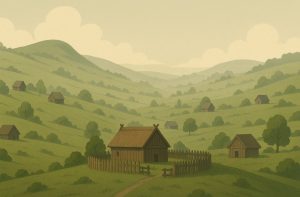What exactly is a “Loiner”? Why do people from Leeds carry such a peculiar and distinctive nickname? Unlike widely recognised terms like “Scouser” or “Geordie,” the word “Loiner” often prompts puzzled looks from those unfamiliar with Yorkshire dialect or the city of Leeds itself. It’s a word that sounds almost mysterious its meaning unclear unless you know the city well.
The term has been in use for generations, yet its origins remain uncertain, with multiple competing theories. In a city steeped in history, culture, and regional pride, it’s no surprise that a simple nickname would spark such debate.
From medieval terminology and ancient settlements to alleyways and working-class communities, the term “Loiner” captures the essence of Leeds in more ways than one.
So, where did this nickname come from and why does it still matter today?
What Are the Historical Origins of the Word “Loiner”?

One of the strongest theories about the origin of “Loiner” dates back over a millennium. In the 8th century, the area now known as Leeds was referred to as Loidis, a term used in ecclesiastical and geographical records.
This early name is widely believed to be the root from which the modern word “Leeds” developed. Over time, Loidis transformed linguistically into “Ledes” or “Leedes” and eventually became “Leeds.”
Supporters of this theory argue that “Loiner” may have evolved in a similar way originating from Loidis, morphing through colloquial use, and eventually becoming the term we recognise today. The phonetic shift from “Loidis” to “Loiner” is not implausible, especially given the fluid nature of dialectal change over centuries.
While this explanation offers a direct link to the city’s ancient identity, it’s not the only contender.
How Might Briggate’s Alleyways Have Influenced the Term?
A second, and perhaps more locally resonant, theory places the origin of the word “Loiner” in the Briggate area of central Leeds. Briggate has long been one of the city’s most historically significant streets.
In the 18th and 19th centuries, it was lined with densely packed buildings, many of which were accessed by narrow alleyways, passageways, and courtyards locally referred to as “ginnels” or “snickets.”
According to this explanation, these alleyways had back entrances or narrow lanes known as “low ins” or “loins.” These hidden pathways became common gathering points for local people, especially workers and residents of tightly packed housing.
Socialising in these areas became a daily part of life for many, and it’s believed that those who frequently gathered in the “loins” came to be known as Loiners.
This theory is deeply embedded in the fabric of working-class Leeds, offering a glimpse into how geography and language intertwine to shape identity. Even today, many of these ginnels still exist, offering a physical connection to the term.
Could “Loiner” Simply Be a Local Dialect Term for “Lane”?

Another theory focuses not on ancient history or specific locations, but on dialect. It proposes that “loin” was a local word for “lane,” a small street or passageway. In this context, “loins” referred to the small roads and spaces between buildings where locals would often gather to talk and exchange gossip.
This linguistic theory suggests that those who frequently stood about in these “loins,” chatting with neighbours and catching up on community affairs, were dubbed Loiners. Over time, the term stuck and began to represent people from Leeds more broadly.
This explanation fits neatly with the culture of informality and close-knit communities that characterised 19th-century Leeds.
With neighbours living practically on top of each other and social interaction happening on the doorstep, it’s no stretch to imagine how people might become identified by their favourite gathering spots.
How Does the Yorkshire Dialect Connect to the Term “Loiner”?
Yorkshire, and Leeds in particular, has a distinctive dialect that can be difficult to decipher for those unfamiliar with it. The local speech is full of unique words and expressions passed down through generations. While “Loiner” may be one of the more obscure terms, it fits within a rich vocabulary that defines the region.
Many of these words, like “ginnel” or “thissen,” reflect the history and identity of the region just as much as “Loiner” does. While the word itself is no longer used daily by all residents, it still pops up in discussions about local identity and heritage, especially in historical or cultural contexts.
Here are some other Yorkshire dialect terms still heard around Leeds:
| Term | Meaning | Historical Root |
| Mardy | Sulky or moody | Derived from “marred” (spoiled) |
| Bray | To hit or strike | From Old French “breier” |
| Monk on | To be in a bad mood | Possibly from “get one’s monkey up” |
| Thissen | Yourself | Combination of “thy” and “self” |
| Ey up | A greeting similar to “hello” | Possibly Old Norse |
| Nithered | Extremely cold | Used across the North of England |
| Bobby dazzler | Someone or something that stands out impressively | Mid-19th century origin |
This linguistic richness supports the idea that “Loiner” could very well be a natural development from local speech rather than a constructed or imposed label.
Is “Loiner” Still Used in Leeds Today?

The term “Loiner” is still recognised in Leeds, although its use has shifted over time. While it may not be as commonly used in everyday speech among younger generations, it hasn’t vanished.
It often appears in:
- Cultural references, such as books, articles, and documentaries about Leeds
- Local newspapers and historical retrospectives
- Sporting contexts, especially among fans of rugby league or community clubs
- Educational or heritage events that celebrate Leeds’ unique identity
In some cases, locals embrace the term with pride, especially those who are passionate about Leeds’ distinct culture and history. In other cases, the word is used more tongue-in-cheek or nostalgically.
The continuing presence of the word in media and conversation suggests that “Loiner” still holds a place of value in the regional vocabulary, even if it is now more symbolic than practical.
What Is the Difference Between a “Loiner” and a “Leodensian”?
While both terms are used to describe people from Leeds, they serve different functions and contexts.
| Term | Style | Common Use | Origin |
| Loiner | Informal | Local dialect, cultural or casual use | Possibly from “loins” or dialect |
| Leodensian | Formal | Educational, historical, ceremonial | From Latin “Leodis” |
For example, someone graduating from a Leeds-based grammar school might be described as a Leodensian alumnus, whereas a sports fan cheering on their local team might proudly call themselves a Loiner.
The two terms are not in competition; rather, they highlight the multifaceted identity of Leeds one rooted in both classical tradition and everyday working-class culture.
How Does the Nickname Compare to Other Regional UK Terms?
Regional nicknames are a cherished part of British identity, and nearly every major city has one. These names often carry history, local pride, or even a touch of humour.
Let’s compare a few notable examples:
| City | Nickname | Explanation |
| Leeds | Loiner | Possibly from “Loidis” or local “loins” |
| Liverpool | Scouser | From “lobscouse,” a sailor’s stew |
| Newcastle | Geordie | Named after King George supporters |
| Birmingham | Brummie | From “Brummagem,” an old name for Birmingham |
| Sheffield | Dee-Dah | From the local accent’s distinctive sound |
Compared to others, “Loiner” stands out for its ambiguity and multiple layers of meaning, making it one of the more intriguing regional nicknames in the UK.
Why Does the Term “Loiner” Still Matter Today?
The enduring value of the term “Loiner” lies in what it represents. It connects modern residents to their shared history, reinforces a sense of place and community, and preserves a linguistic thread that might otherwise be lost.
In an era where cities are growing and changing rapidly, maintaining a link to the past through language can be a powerful reminder of identity. “Loiner” isn’t just a word it’s a symbol of Leeds’ evolution from medieval settlement to industrial powerhouse to contemporary city.
It may not be universally used in daily conversation, but it remains a beloved part of local heritage, championed by historians, writers, and proud residents.
What Are the Competing Theories Behind the Word “Loiner”?
| Theory | Summary | Historical Context |
| Loidis Origin | Derived from the 8th-century name for the Leeds region | Early medieval England |
| Briggate Alleyways Theory | Named after residents gathering in “loins” near Briggate | 18th–19th century Leeds |
| Local Dialect Theory | “Loins” was a local term for “lanes” where neighbours chatted | Yorkshire dialect culture |
Each theory offers a different window into the city’s history, making “Loiner” a truly layered and complex term.
Frequently Asked Questions
What does “Loiner” mean?
It’s a nickname for someone from Leeds, possibly derived from historical names or local alleyways.
Is “Loiner” still a common term in Leeds?
It’s recognised but less frequently used in everyday speech; it appears in cultural and historical references.
What is a “ginnel” in Leeds?
A narrow alleyway or passage between buildings, commonly found in older parts of the city.
What’s the origin of the word “Mardy”?
“Mardy” comes from “marred” (spoiled) and means sulky or moody. It’s widely used in Yorkshire.
Are “Loiner” and “Leodensian” the same?
They both refer to people from Leeds, but “Loiner” is informal, while “Leodensian” is more formal and ceremonial.
How old is the word “Loiner”?
It’s not precisely dated, but its usage dates back at least to the 19th century, possibly earlier.
Why are regional nicknames important?
They preserve local identity, history, and cultural uniqueness through language.






